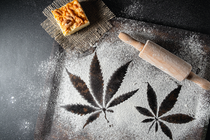Meet the Other Common Cannabinoids in Cannabis

In addition to CBD and THC, there are hundreds of other phytocannabinoids that are unique to cannabis, each offering different characteristics when interacting with the endocannabinoid system. While THC and CBD are the most well studied and most prominent cannabinoids, below is an overview of some others that you might come across as you begin your cannabis journey.
The following overview is an excerpt from my book, The Ultimate Guide to CBD, available on Amazon, Barnes & Noble, plus more.
Meet the Other Common Cannabinoids in Cannabis
CBC – Cannabichromene
Stemming from the same origins as both CBD and THC, CBC is a nonintoxicating cannabinoid that activates non-cannabinoid receptors in the body such as TRPV1 and TRPA1. Similar to CBD, CBC interacts with certain receptors that boost levels of endocannabinoids such as anandamide (AEA). CBC also acts as an anti-inflammatory, increases healthy brain function, and can potentially help treat acne.
CBDA – Cannabidiolic Acid
CBDA is the acidic precursor of CBD that’s created by CBGA. CBDA does not interact with the usual elements of the endocannabinoid system, but it does produce anti-inflammatory effects similar to CBD. CBDA also acts as an anti-nausea supplement and could be an effective treatment for morning sickness. Leading cannabinoid researcher Dr. Michele Ross reports that it might also be better at lowering anxiety than CBD, at least in rodents. To integrate CBDA into your routine, try juicing raw CBD-rich cannabis leaves (unheated and not dried).
CBDV– Cannabidivarin
CBDV is a nonintoxicating cannabinoid that reduces the severity of seizures; therefore, it could be a suitable option for battling epilepsy. Research is also indicating that CBDV can potentially reduce or eliminate nausea associated with several conditions.
CBG – Cannabigerol
CBG is a lesser-known nonintoxicating cannabinoid that's present in small quantities in most strains. Beginning as CBGA or cannabigerolic acid, cannabis plants produce this cannabinoid which later turns into THCA, CBDA or CBCA, depending on the enzymes that make up the plant. While difficult to capture on its own, CBG acts as an anti-inflammatory, anti-anxiety, antibacterial, as well as produces other positive side effects.
CBN – Cannabinol
If you’re looking for a good night’s rest, CBN might be your new best friend. Produced by the oxidation of THC and degradation from heat and light after the flower is harvested, CBN is mildly intoxicating and is best known for its sedative side effects. If you’ve ever consumed an old bag of weed and felt really tired, pronounced levels of CBN could be the culprit. Besides the sedative effects, CBN can be used as a mild pain reliever and act as an appetite stimulant.
THC – Tetrahydrocannabinol
I know that you’ve already learned a little bit about THC, but given its importance, there is more ground to cover. Delta-9-tetrahydrocannabinol is the primary intoxicating component of cannabis that’s created when THCA is exposed to heat via decarboxylation. Found in several different variations, THC binds directly to CB1 and CB2 receptors delivering a broad range of therapeutic benefits including pain relief, anti-inflammation, anti-nausea, acts as a sleep aid, plus more. If overconsumed, THC can present some unpleasant side effects such as paranoia. For beginners, combine THC with CBD for best results.
THCA – Tetrahydrocannabinolic Acid
THCA is the nonintoxicating acid form of THC that’s created by CBGA. It is the most prominent compound that’s found in raw cannabis. Unlike THC, THCA doesn’t cross the blood-brain-barrier and only activates CB1 and CB2 receptors in the body, not the brain. Because it’s nonintoxicating, THCA is quickly gaining popularity and provides many health benefits. For example, THCA can increase the appetite and reduce nausea and vomiting. It also acts as a powerful anti-inflammatory and pain reliever without the psychoactivity of THC. Because THCA converts to THC via decarboxylation, it’s best to keep TCHA products away from heat and store in a cool place if you wish to consume the cannabinoid in its in nonintoxicating form.
THCV – Tetrahyrdocannabivarin
Quickly gaining the attention of those seeking an option for weight loss, THCV is a variation of THC that is known to suppress the appetite. Because of its interaction with CB1 receptors, THCV reduces feelings that evoke hunger and presents some intoxicating effects. THCV can also be somewhat stimulating, so it might not be effective for sleep.
For more information, resources, and references, please pick up a copy of my book, The Ultimate Guide to CBD.

About the Author:

Jamie Evans is the founder of The Herb Somm and author of The Ultimate Guide to CBD: Explore the World of Cannabidiol and Cannabis Drinks: Secrets to Crafting CBD and THC Beverages at Home. She is an author, entrepreneur, and writer specializing in cannabis, food, recipes, wine, and the canna-culinary world. In addition to her work in the cannabis industry, Jamie has over a decade of wine industry experience and is a Certified Sommelier. Having represented a wide array of organizations and wineries, she is best known for her literary work and producing high-end events. She was also named as one of Wine Enthusiast Magazine’s Top 40 Under 40 Tastemakers in 2018. Follow her on Instagram and Twitter @TheHerbSomm.
.png)


















Comments